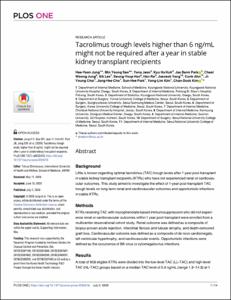KUMEL Repository
1. Journal Papers (연구논문)
1. School of Medicine (의과대학)
Dept. of Internal Medicine (내과학)
Tacrolimus trough levels higher than 6 ng/mL might not be required after a year in stable kidney transplant recipients
- Affiliated Author(s)
- 한승엽
- Alternative Author(s)
- Han, Seung Yeup
- Journal Title
- PLoS One
- ISSN
- 1932-6203
- Issued Date
- 2020
- Abstract
- Background:
Little is known regarding optimal tacrolimus (TAC) trough levels after 1 year post-transplant in stable kidney transplant recipients (KTRs) who have not experienced renal or cardiovascular outcomes. This study aimed to investigate the effect of 1-year post-transplant TAC trough levels on long-term renal and cardiovascular outcomes and opportunistic infections in stable KTRs.
Methods:
KTRs receiving TAC with mycophenolate-based immunosuppression who did not experience renal or cardiovascular outcomes within 1 year post-transplant were enrolled from a multicenter observational cohort study. Renal outcome was defined as a composite of biopsy-proven acute rejection, interstitial fibrosis and tubular atrophy, and death-censored graft loss. Cardiovascular outcome was defined as a composite of de novo cardiomegaly, left ventricular hypertrophy, and cardiovascular events. Opportunistic infections were defined as the occurrence of BK virus or cytomegalovirus infections.
Results:
A total of 603 eligible KTRs were divided into the low-level TAC (LL-TAC) and high-level TAC (HL-TAC) groups based on a median TAC level of 5.9 ng/mL (range 1.3-14.3) at 1 year post-transplant. The HL-TAC group had significantly higher TAC trough levels at 2, 3, 4, and 5 years compared with the levels of the LL-TAC group. During the mean follow-up of 63.7 ± 13.0 months, there were 121 renal outcomes and 224 cardiovascular outcomes. In multivariate Cox regression analysis, LL-TAC and HL-TAC were not independent risk factors for renal and cardiovascular outcomes, respectively. No significant differences in the development of opportunistic infections and de novo donor-specific anti-human leukocyte antigen antibodies and renal allograft function were observed between the two groups.
Conclusions:
TAC trough levels after 1 year post-transplant remained at a similar level until the fifth year after kidney transplantation and were not directly associated with long-term outcomes in stable Korean KTRs who did not experience renal or cardiovascular outcomes. Therefore, in Asian KTRs with a stable clinical course, TAC trough levels higher than approximately 6 ng/mL might not be required after a year of kidney transplantation.
- Department
- Dept. of Internal Medicine (내과학)
- Publisher
- School of Medicine (의과대학)
- Citation
- Hee-Yeon Jung et al. (2020). Tacrolimus trough levels higher than 6 ng/mL might not be required after a year in stable kidney transplant recipients. PLoS One, 15(7), e0235418. doi: 10.1371/journal.pone.0235418
- Type
- Article
- ISSN
- 1932-6203
- Appears in Collections:
- 1. School of Medicine (의과대학) > Dept. of Internal Medicine (내과학)
- 파일 목록
-
-
Download
 oak-2020-0536.pdf
기타 데이터 / 1.05 MB / Adobe PDF
oak-2020-0536.pdf
기타 데이터 / 1.05 MB / Adobe PDF
-
Items in Repository are protected by copyright, with all rights reserved, unless otherwise indicated.